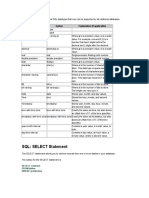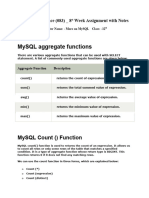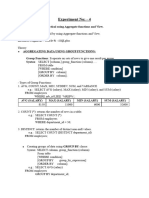SQL Command
Uploaded by
JoeZegaSQL Command
Uploaded by
JoeZegaSQL: Function
The COUNT function returns the number of rows in a query.
The syntax for the COUNT function is:
SELECT COUNT(expression)
FROM tables
WHERE predicates;
Note:
The COUNT function will only count those records in which the field in the brackets is NOT NULL.
For example, if you have the following table called suppliers:
Supplier_ID Supplier_Name State
1 IBM CA
2 Microsof
3 NVIDIA
The result for this query will return 3.
Select COUNT(Supplier_ID) from suppliers;
While the result for the next query will only return 1, since there is only one row in the suppliers tab
Select COUNT(State) from suppliers;
Simple Example:
For example, you might wish to know how many employees have a salary that is above $25,000 / ye
SELECT COUNT(*) as "Number of employees"
FROM employees
WHERE salary > 25000;
In this example, we've aliased the count(*) field as "Number of employees". As a result, "Number of
Example using DISTINCT:
You can use the DISTINCT clause within the COUNT function.
For example, the SQL statement below returns the number of unique departments where at least on
SELECT COUNT(DISTINCT department) as "Unique departments"
FROM employees
WHERE salary > 25000;
Again, the count(DISTINCT department) field is aliased as "Unique departments". This is the field na
Example using GROUP BY:
In some cases, you will be required to use a GROUP BY clause with the COUNT function.
For example, you could use the COUNT function to return the name of the department and the num
SELECT department, COUNT(*) as "Number of employees"
FROM employees
WHERE salary > 25000
GROUP BY department;
Because you have listed one column in your SELECT statement that is not encapsulated in the COUN
TIP: Performance Tuning
Since the COUNT function will return the same results regardless of what NOT NULL field(s) you inclu
For example, based on the example above, the following syntax would result in better performance:
SELECT department, COUNT(1) as "Number of employees"
FROM employees
WHERE salary > 25000
GROUP BY department;
Now, the COUNT function does not need to retrieve all fields from the employees table as it had to w
Practice Exercise #1:
Based on the employees table populated with the following data, count the number of employees w
CREATE TABLE employees
( employee_number number(10not null,
employee_name varchar2(5 not null,
salary number(6),
CONSTRAINT employees_pk PRIMARY KEY (employee_number)
);
INSERT INTO employees (employee_number, employee_name, salary)
VALUES (1001, 'John Smith', 62000);
INSERT INTO employees (employee_number, employee_name, salary)
VALUES (1002, 'Jane Anderson', 57500);
INSERT INTO employees (employee_number, employee_name, salary)
VALUES (1003, 'Brad Everest', 71000);
INSERT INTO employees (employee_number, employee_name, salary)
VALUES (1004, 'Jack Horvath', 42000);
Solution:
Although inefficient in terms of performance, the following SQL statement would return the number
SELECT COUNT(*) as "Number of employees"
FROM employees
WHERE salary > 55000;
It would return the following result set:
Number of employees
3
A more efficient implementation of the same solution would be the following SQL statement:
SELECT COUNT(1) as "Number of employees"
FROM employees
WHERE salary > 55000;
Now, the COUNT function does not need to retrieve all of the fields from the table (ie: employee_nu
Practice Exercise #2:
Based on the suppliers table populated with the following data, count the number of distinct cities in
CREATE TABLE suppliers
( supplier_id number(10not null,
supplier_name varchar2(5 not null,
city varchar2(50),
CONSTRAINT suppliers_pk PRIMARY KEY (supplier_id)
);
INSERT INTO suppliers (supplier_id, supplier_name, city)
VALUES (5001, 'Microsof', 'New York');
INSERT INTO suppliers (supplier_id, supplier_name, city)
VALUES (5002, 'IBM', 'Chicago');
INSERT INTO suppliers (supplier_id, supplier_name, city)
VALUES (5003, 'Red Hat', 'Detroit');
INSERT INTO suppliers (supplier_id, supplier_name, city)
VALUES (5004, 'NVIDIA', 'New York');
INSERT INTO suppliers (supplier_id, supplier_name, city)
VALUES (5005, 'NVIDIA', 'LA');
Solution:
The following SQL statement would return the number of distinct cities in the suppliers table:
SELECT COUNT(DISTINCT city) as "Distinct Cities"
FROM suppliers;
It would return the following result set:
Distinct Cities
4
Practice Exercise #3:
Based on the customers table populated with the following data, count the number of distinct cities
CREATE TABLE customers
( customer_id number(10not null,
customer_name varchar2(5 not null,
city varchar2(50),
CONSTRAINT customers_pk PRIMARY KEY (customer_id)
);
INSERT INTO customers (customer_id, customer_name, city)
VALUES (7001, 'Microsof', 'New York');
INSERT INTO customers (customer_id, customer_name, city)
VALUES (7002, 'IBM', 'Chicago');
INSERT INTO customers (customer_id, customer_name, city)
VALUES (7003, 'Red Hat', 'Detroit');
INSERT INTO customers (customer_id, customer_name, city)
VALUES (7004, 'Red Hat', 'New York');
INSERT INTO customers (customer_id, customer_name, city)
VALUES (7005, 'Red Hat', 'San Francisco');
INSERT INTO customers (customer_id, customer_name, city)
VALUES (7006, 'NVIDIA', 'New York');
INSERT INTO customers (customer_id, customer_name, city)
VALUES (7007, 'NVIDIA', 'LA');
INSERT INTO customers (customer_id, customer_name, city)
VALUES (7008, 'NVIDIA', 'LA');
Solution:
The following SQL statement would return the number of distinct cities for each customer_name in
SELECT customer_name, COUNT(DISTINCT city) as "Distinct Cities"
FROM customers
GROUP BY customer_name;
It would return the following result set:
CUSTOMER_NAME Distinct Cities
IBM 1
Microsof 1
NVIDIA 2
Red Hat 3
e brackets is NOT NULL.
ne row in the suppliers table where the State field is NOT NULL.
that is above $25,000 / year.
s". As a result, "Number of employees" will display as the field name when the result set is returned.
artments where at least one employee makes over $25,000 / year.
ments". This is the field name that will display in the result set.
UNT function.
e department and the number of employees (in the associated department) that make over $25,000 / year.
encapsulated in the COUNT function, you must use a GROUP BY clause. The department field must, therefore, be listed in the GROUP B
NOT NULL field(s) you include as the COUNT function parameters (ie: within the brackets), you can change the syntax of the COUNT fun
ult in better performance:
ployees table as it had to when you used the COUNT(*) syntax. It will merely retrieve the numeric value of 1 for each record that meets
he number of employees whose salary is over $55,000 per year.
t would return the number of employees whose salary is over $55,000 per year.
wing SQL statement:
he table (ie: employee_number, employee_name, and salary), but rather whenever the condition is met, it will retrieve the numeric va
number of distinct cities in the suppliers table:
the suppliers table:
e number of distinct cities for each customer_name in the customers table:
r each customer_name in the customers table:
herefore, be listed in the GROUP BY section.
hange the syntax of the COUNT function to COUNT(1) to get better performance as the database engine will not have to fetch back the
ue of 1 for each record that meets your criteria.
met, it will retrieve the numeric value of 1. Thus, increasing the performance of the SQL statement.
ne will not have to fetch back the data fields.
You might also like
- A Small List of Operating Oil and Gas Fields in Myanmar by Production LevelNo ratings yetA Small List of Operating Oil and Gas Fields in Myanmar by Production Level6 pages
- Detailed Lesson Plan in Science 9: (Presentation of Assigned Task Per Group)No ratings yetDetailed Lesson Plan in Science 9: (Presentation of Assigned Task Per Group)6 pages
- Techniques Used to Transform Data, Part 1No ratings yetTechniques Used to Transform Data, Part 112 pages
- My SQL Worksheet-3 (Aggregate Functions)No ratings yetMy SQL Worksheet-3 (Aggregate Functions)7 pages
- 4 Group by Clause, Having Clause, Multiple Row (Or Group or Aggregate) Functions100% (1)4 Group by Clause, Having Clause, Multiple Row (Or Group or Aggregate) Functions17 pages
- Learn SQL - Aggregate Functions Cheatsheet - CodecademyNo ratings yetLearn SQL - Aggregate Functions Cheatsheet - Codecademy2 pages
- Unit 2: Database Query Using SQL Syllabus: Single Row FunctionsNo ratings yetUnit 2: Database Query Using SQL Syllabus: Single Row Functions8 pages
- Structured Query Language (SQL) : (Chapter 11)No ratings yetStructured Query Language (SQL) : (Chapter 11)7 pages
- Module 6 - Integrative Coding Using MySQL Functions - Week 11No ratings yetModule 6 - Integrative Coding Using MySQL Functions - Week 1112 pages
- Learn SQL_ Aggregate Functions Cheatsheet _ CodecademyNo ratings yetLearn SQL_ Aggregate Functions Cheatsheet _ Codecademy3 pages
- ITE407 - Advanced Databases Group Fns LectureNotes 02212017No ratings yetITE407 - Advanced Databases Group Fns LectureNotes 022120174 pages
- Learn SQL_ Aggregate Functions Cheatsheet _ CodecademyNo ratings yetLearn SQL_ Aggregate Functions Cheatsheet _ Codecademy2 pages
- Calculating Aggregates - Aggregate Functions Cheatsheet - CodecademyNo ratings yetCalculating Aggregates - Aggregate Functions Cheatsheet - Codecademy3 pages
- PRACTICAL NO-5 To Study Aggregate Functions With Query.No ratings yetPRACTICAL NO-5 To Study Aggregate Functions With Query.4 pages
- Learn SQL - Aggregate Functions Cheatsheet - CodecademyNo ratings yetLearn SQL - Aggregate Functions Cheatsheet - Codecademy2 pages
- Lab - 4 - Retrieving Data From Multiple TablesNo ratings yetLab - 4 - Retrieving Data From Multiple Tables16 pages
- Introduction To Oracle Functions and Group by Clause100% (2)Introduction To Oracle Functions and Group by Clause62 pages
- Database Programming With SQL Section 8 Quiz100% (1)Database Programming With SQL Section 8 Quiz9 pages
- 8-In-Built Functions, Join and Group by Queries-19-03-2024No ratings yet8-In-Built Functions, Join and Group by Queries-19-03-202438 pages
- DB2 11.1 for LUW: SQL Basic Training for Application DevelopersFrom EverandDB2 11.1 for LUW: SQL Basic Training for Application DevelopersNo ratings yet
- Harelaw - PLI - Final PLI Report Dated 17 June 2013No ratings yetHarelaw - PLI - Final PLI Report Dated 17 June 2013231 pages
- Course Objectives:: Unit-I S. No. Blooms Taxonomy Level Program OutcomeNo ratings yetCourse Objectives:: Unit-I S. No. Blooms Taxonomy Level Program Outcome21 pages
- Topic The Longest Journey Begins With The First StepNo ratings yetTopic The Longest Journey Begins With The First Step2 pages
- 2024년 9월 고2 모의고사 11단계중 글의흐름 중점 3단계 66문제(한글)eNo ratings yet2024년 9월 고2 모의고사 11단계중 글의흐름 중점 3단계 66문제(한글)e20 pages
- FSCUT2000C Laser Cutting Control System User ManualV3.1100% (1)FSCUT2000C Laser Cutting Control System User ManualV3.169 pages
- Q1. What Are The Things You Need To Consider in Choosing An Operating System?No ratings yetQ1. What Are The Things You Need To Consider in Choosing An Operating System?2 pages
- (eBook PDF) Managing and Organizations: An Introduction to Theory and Practice 5th Editionpdf downloadNo ratings yet(eBook PDF) Managing and Organizations: An Introduction to Theory and Practice 5th Editionpdf download55 pages

























































































